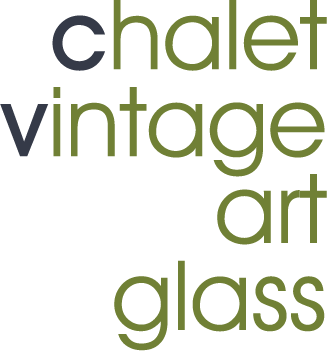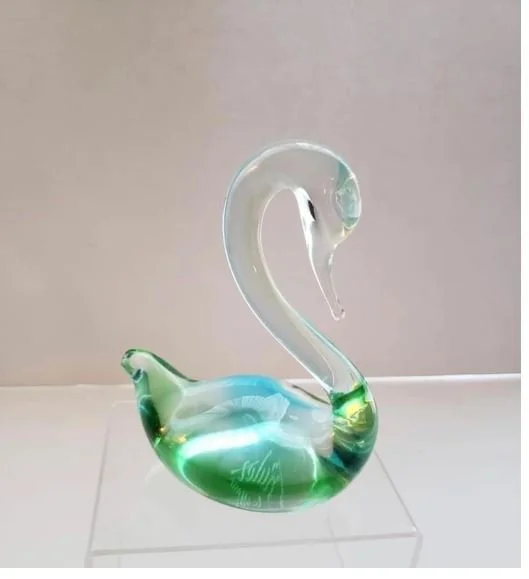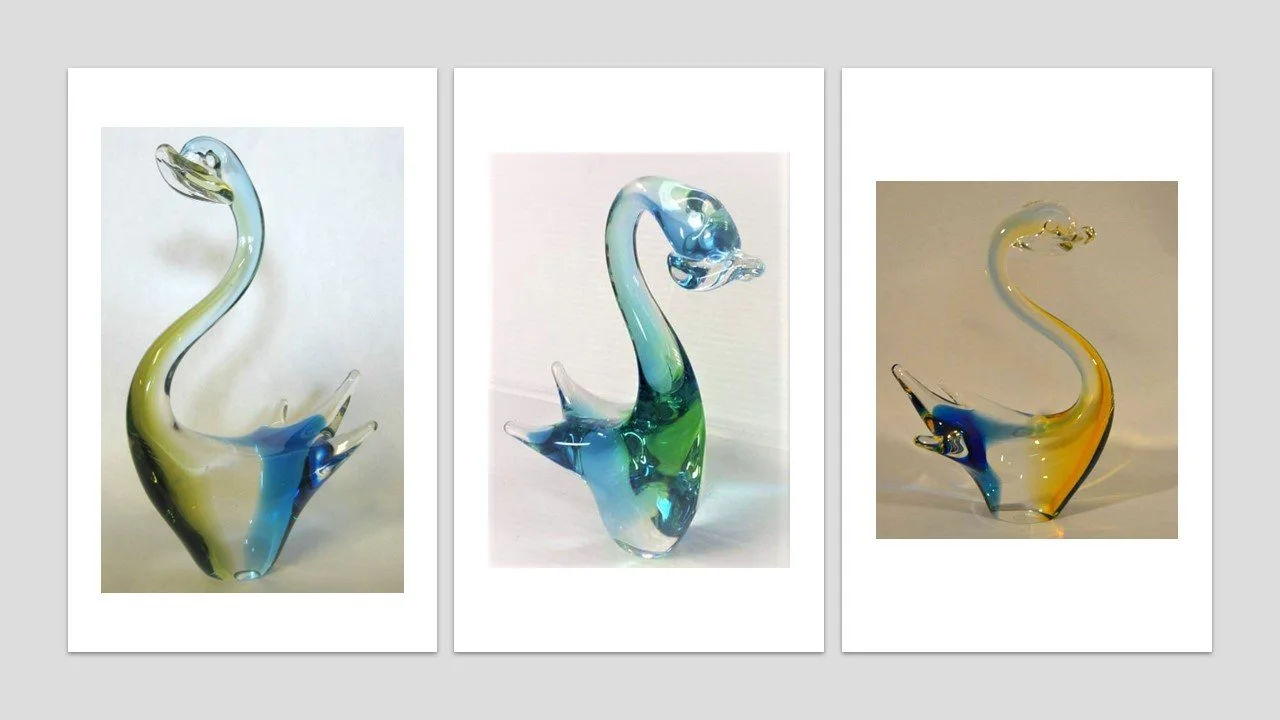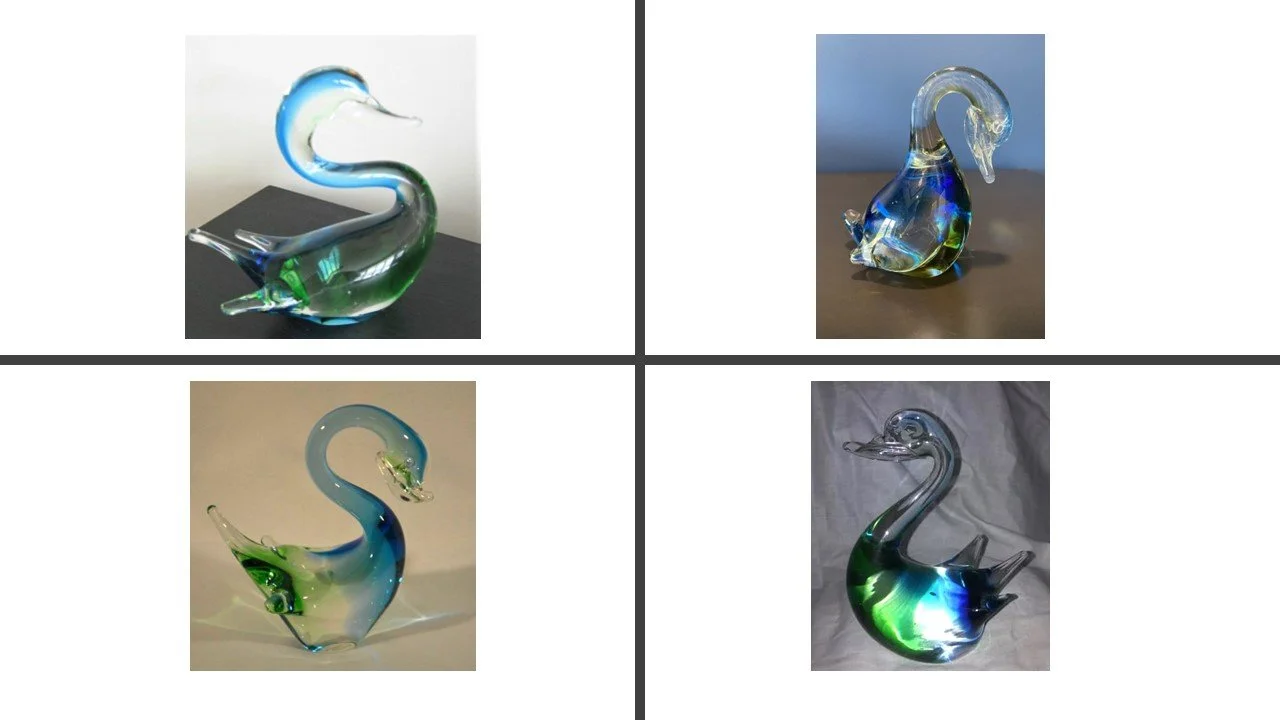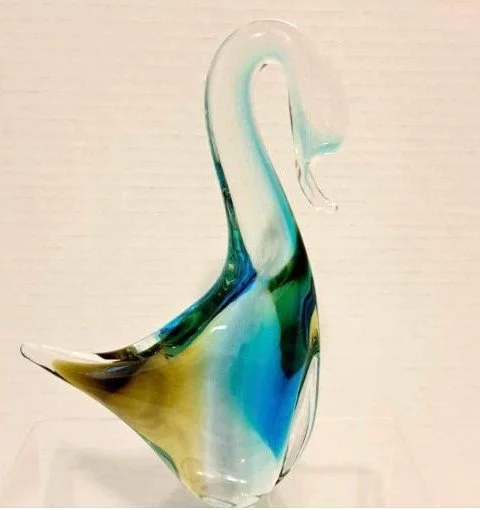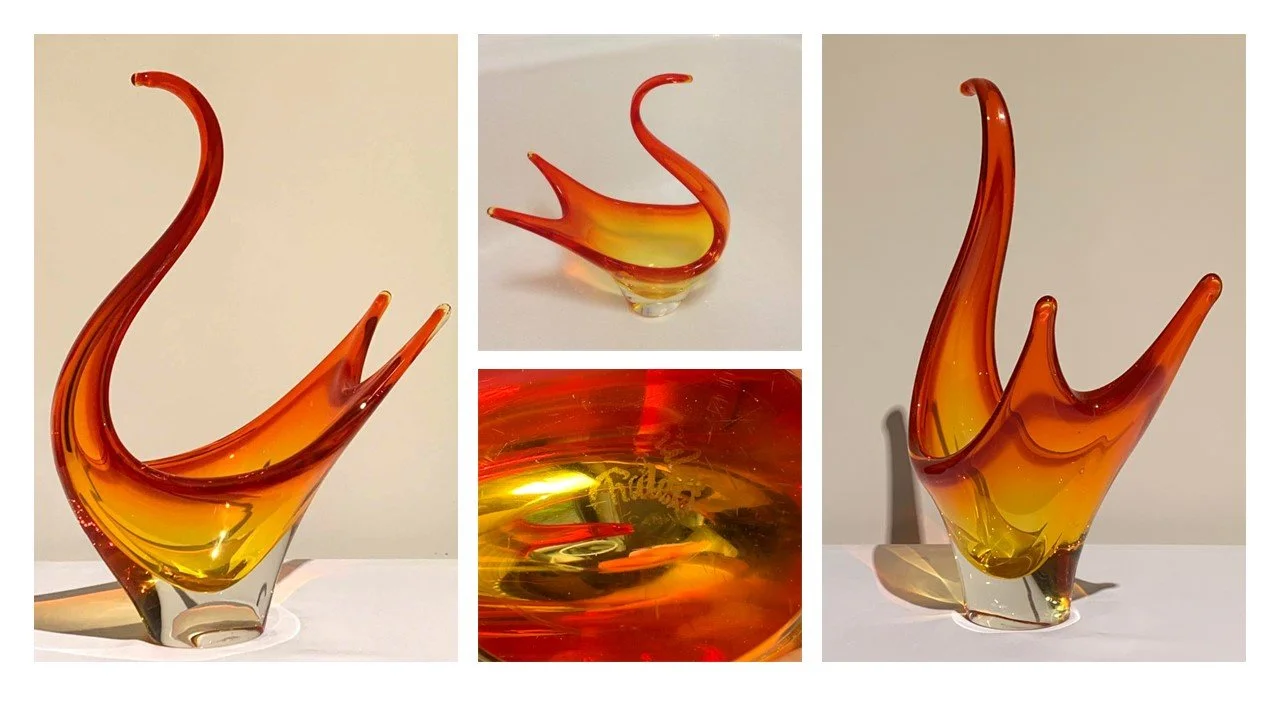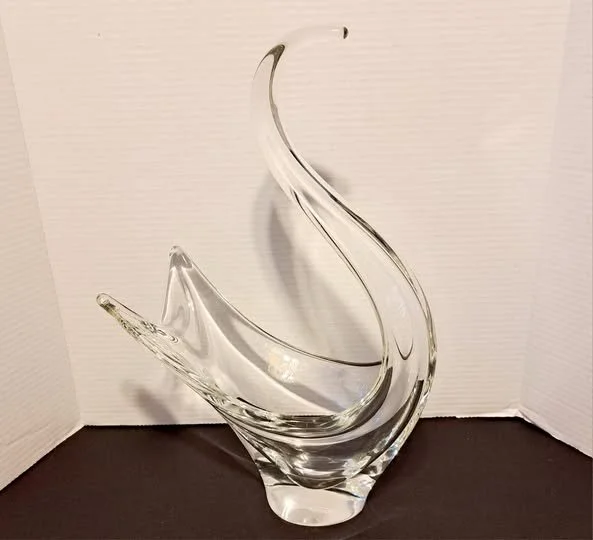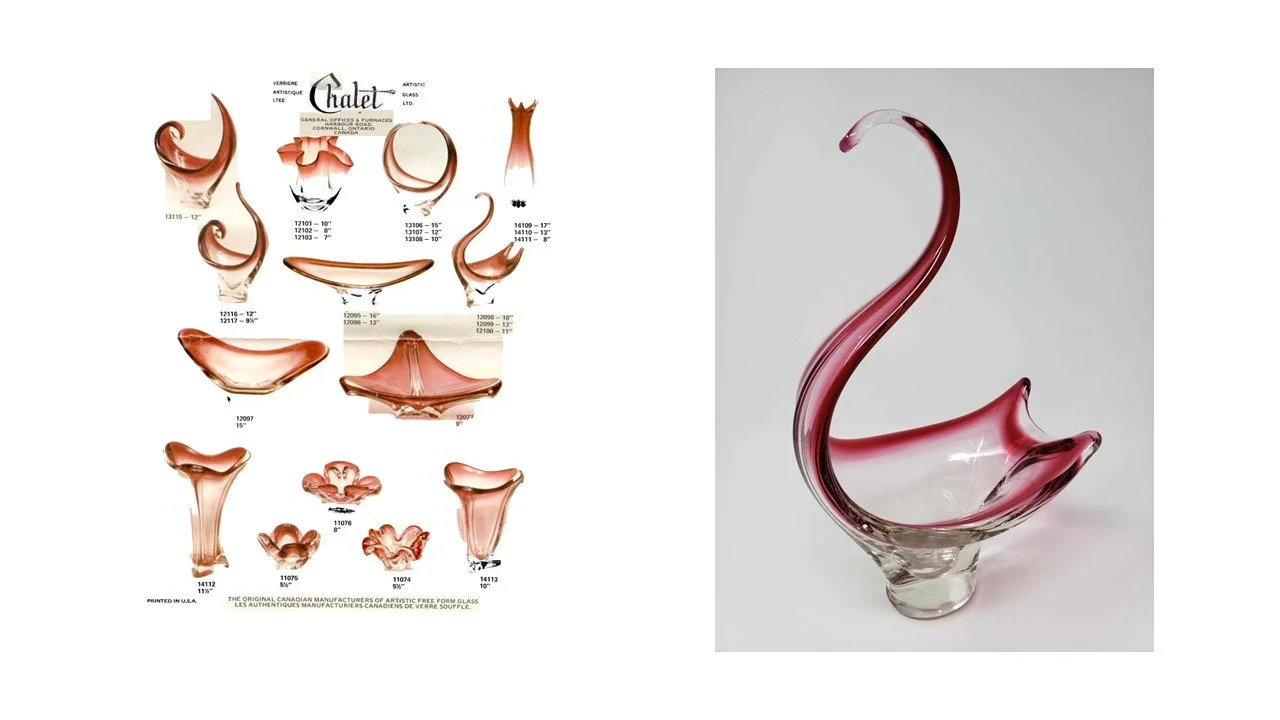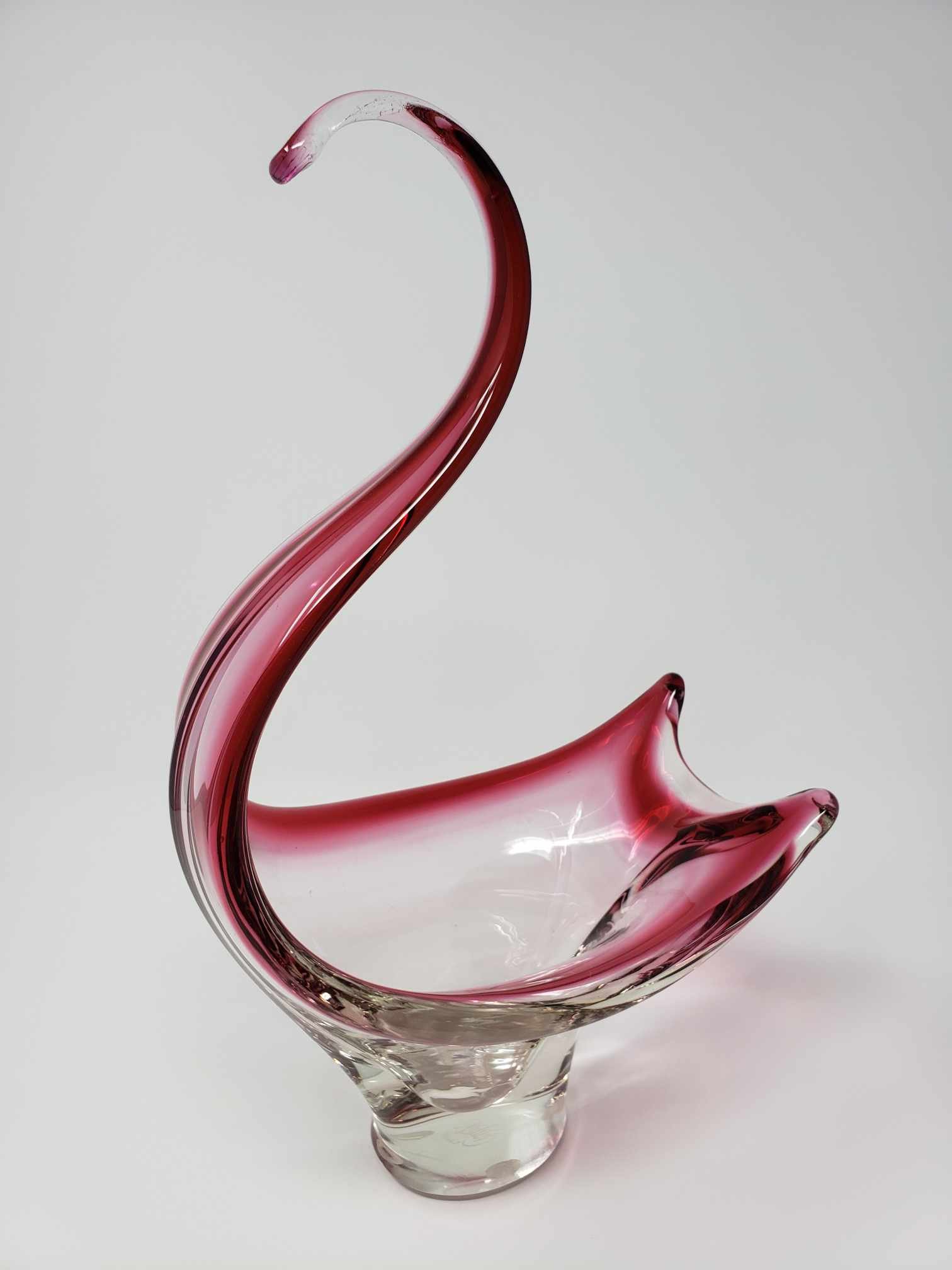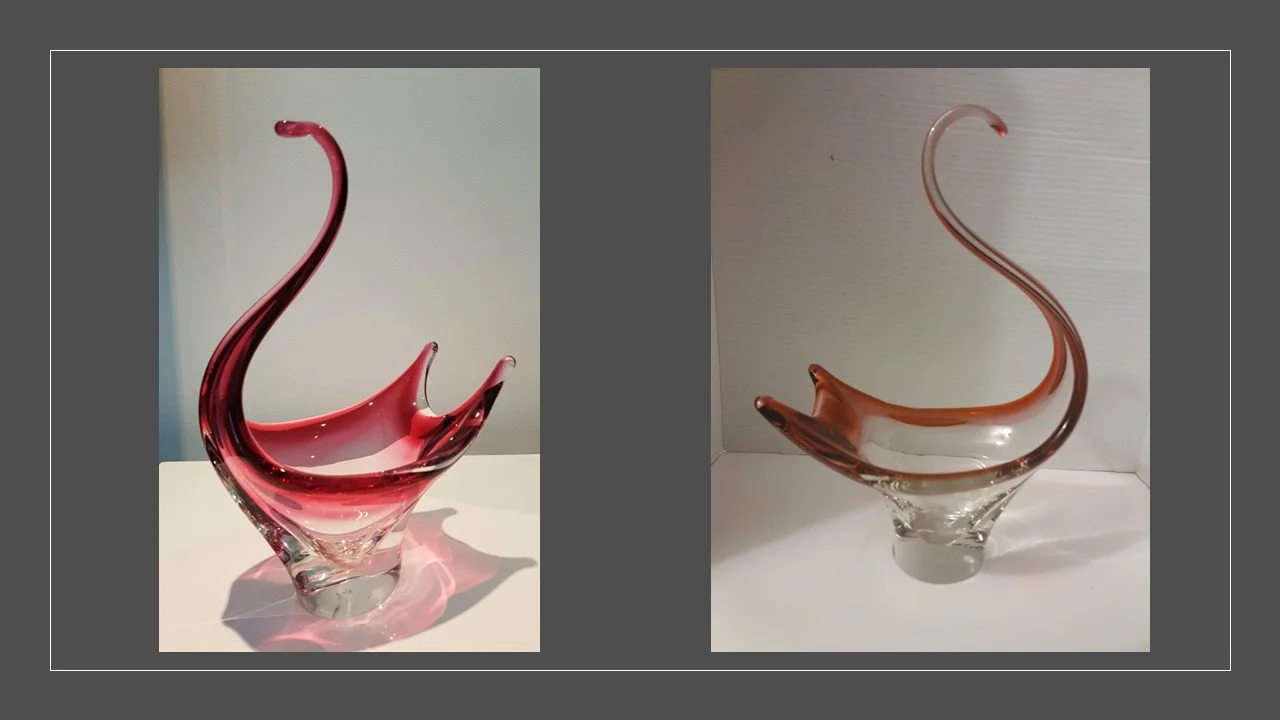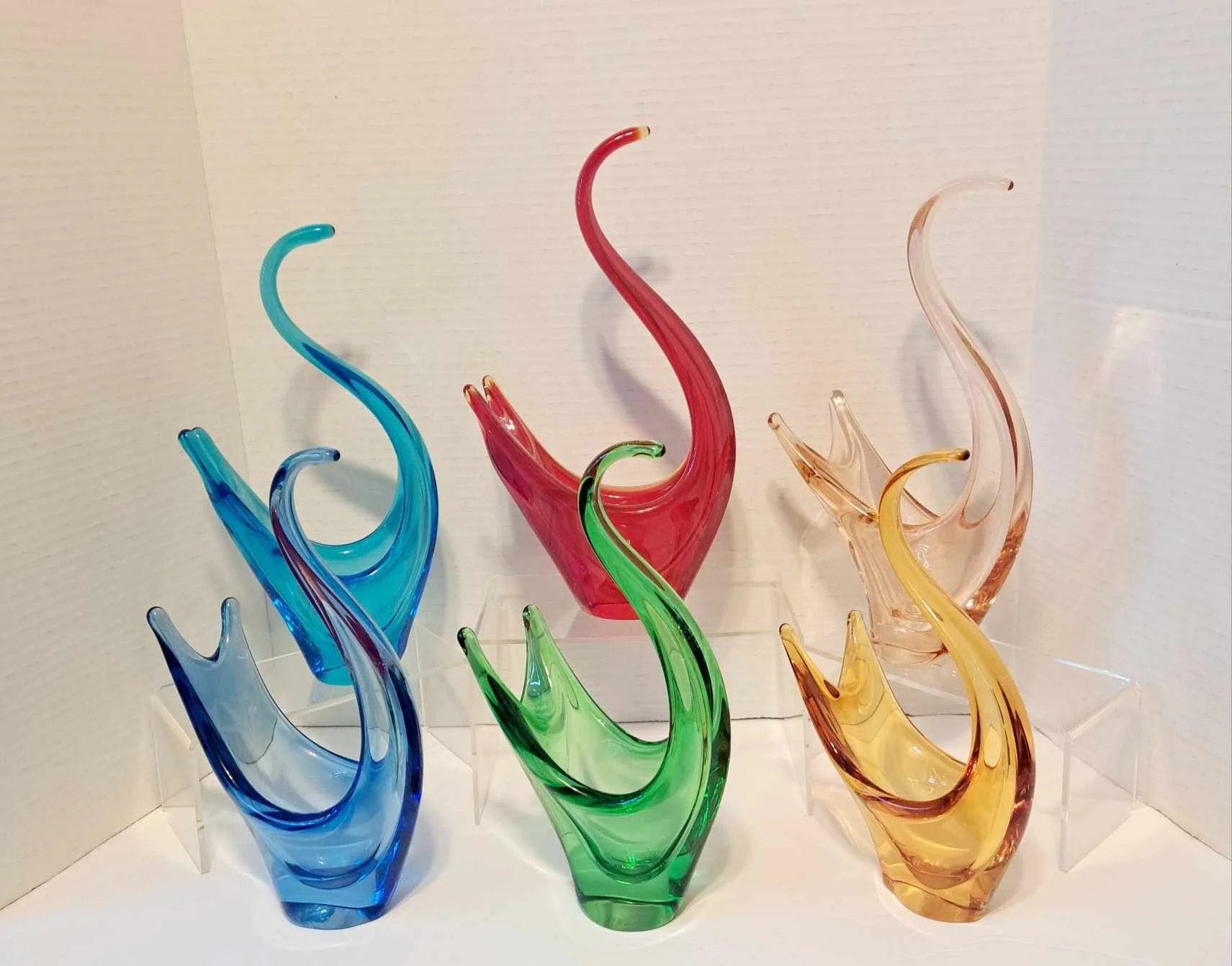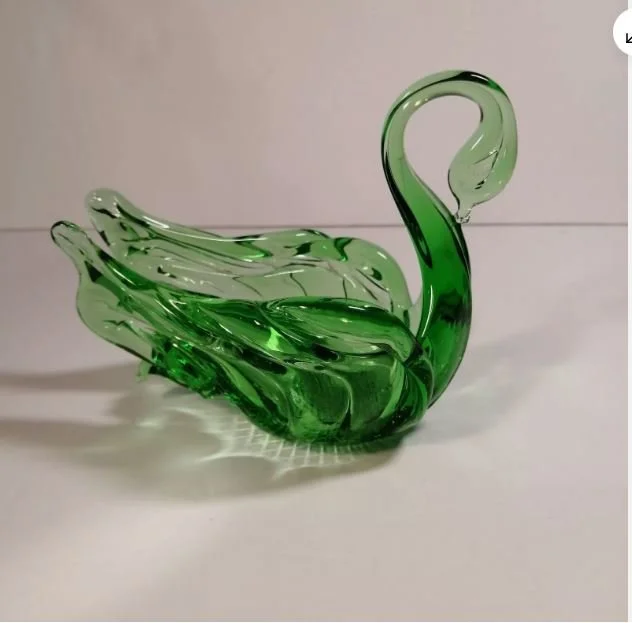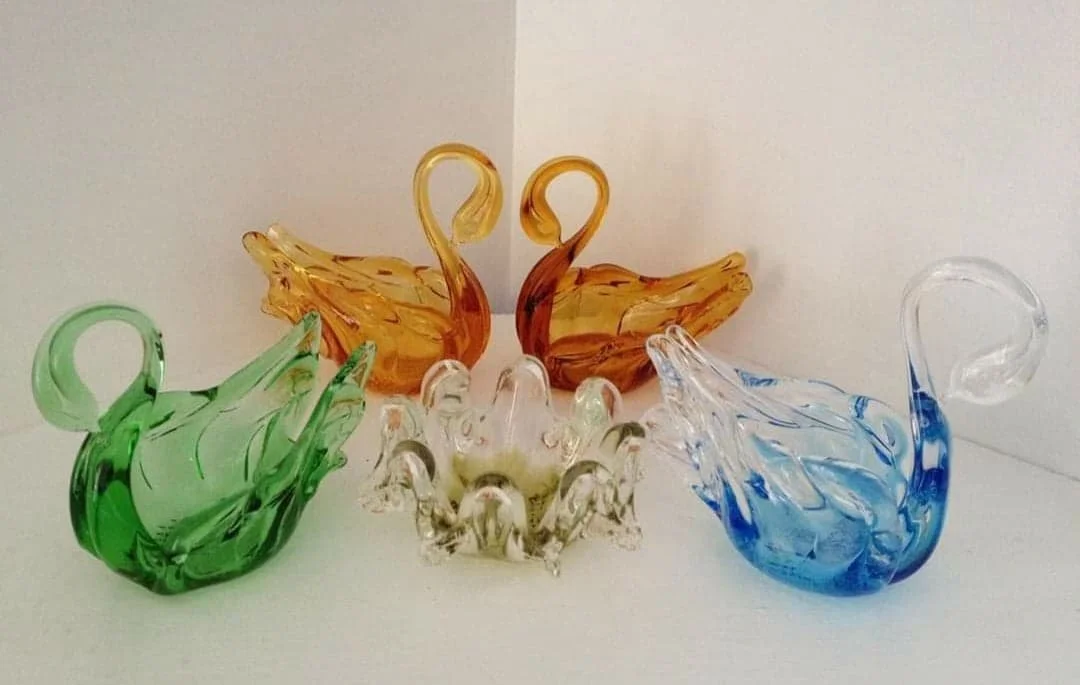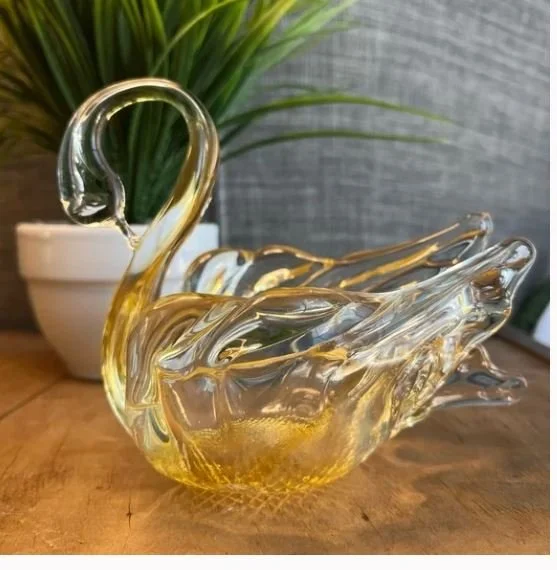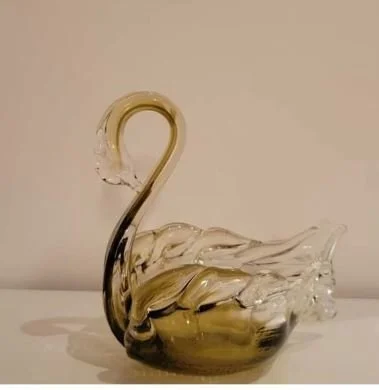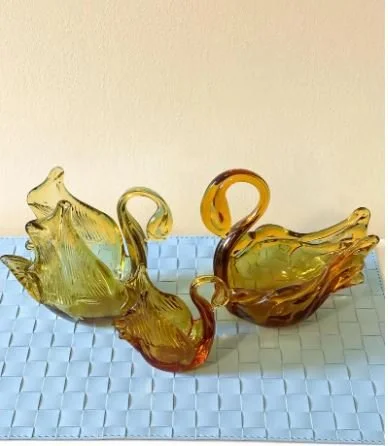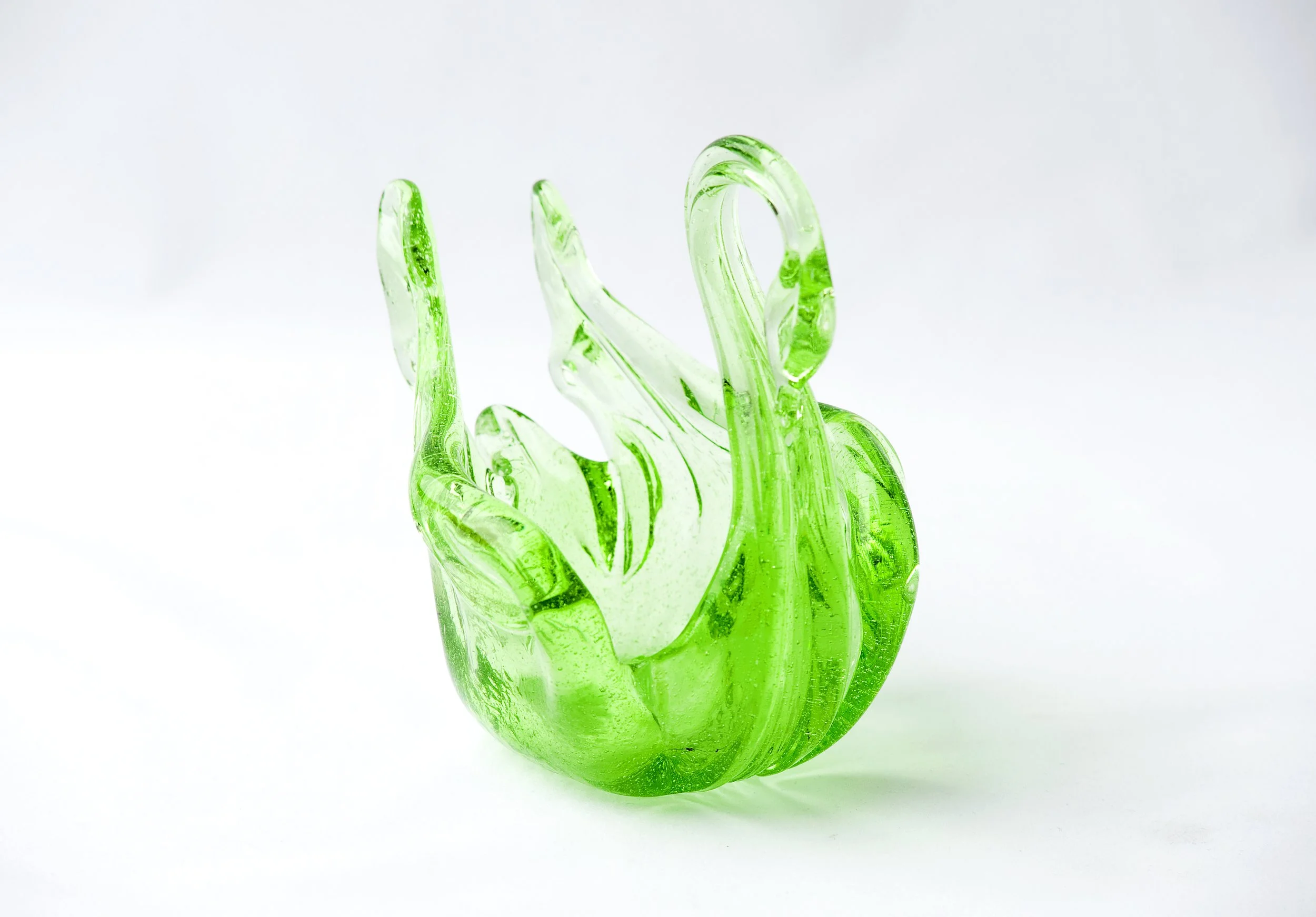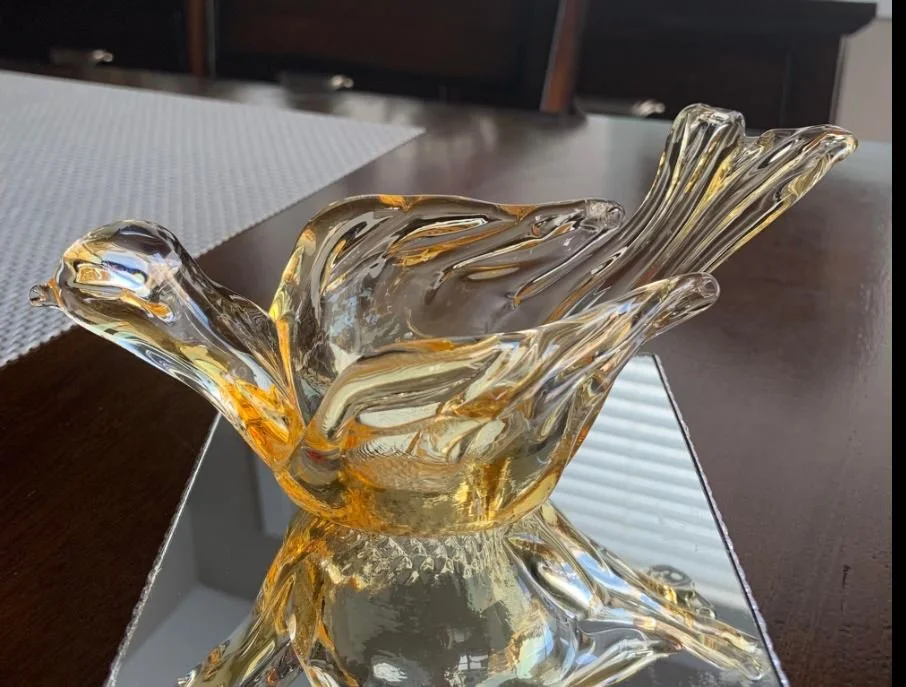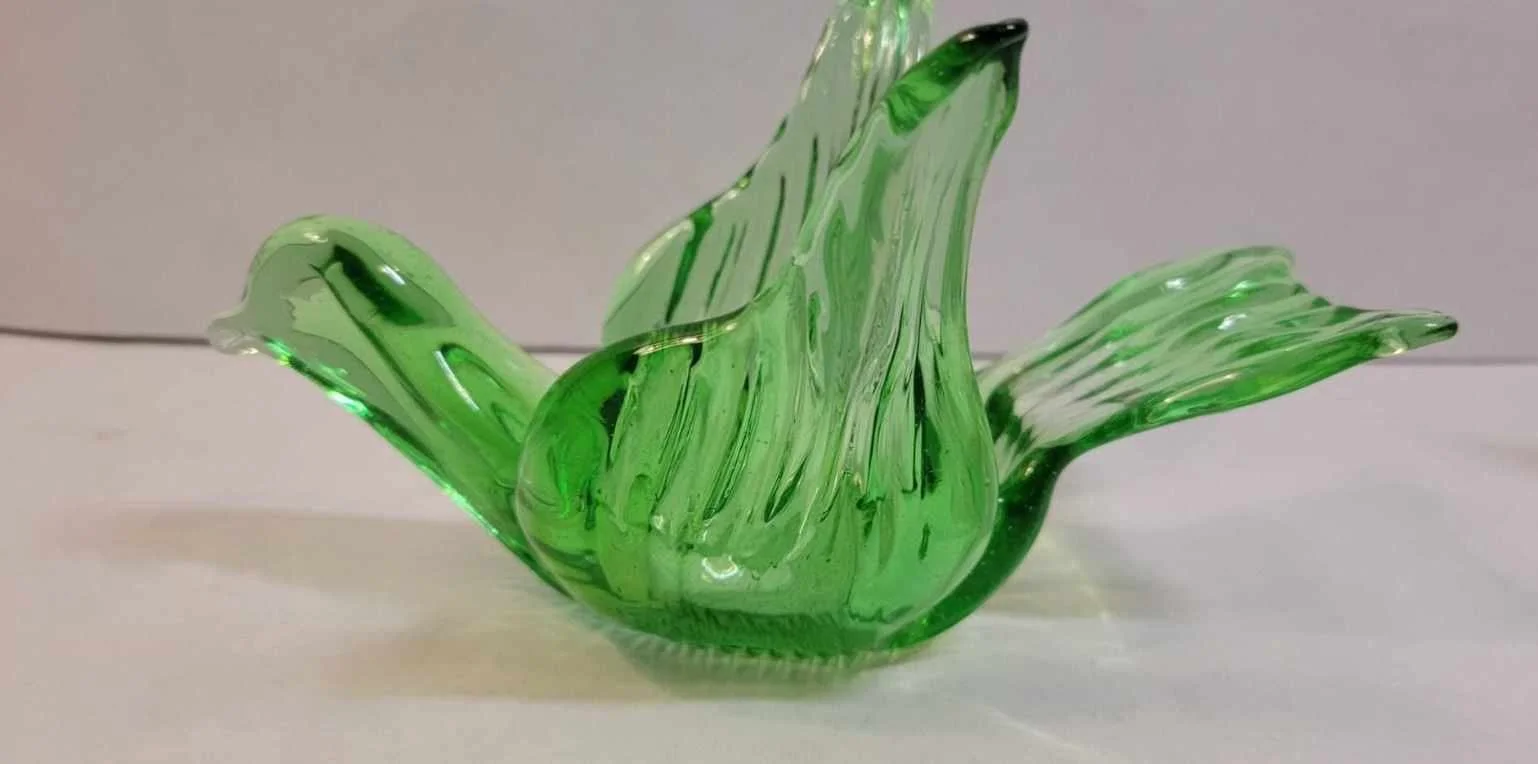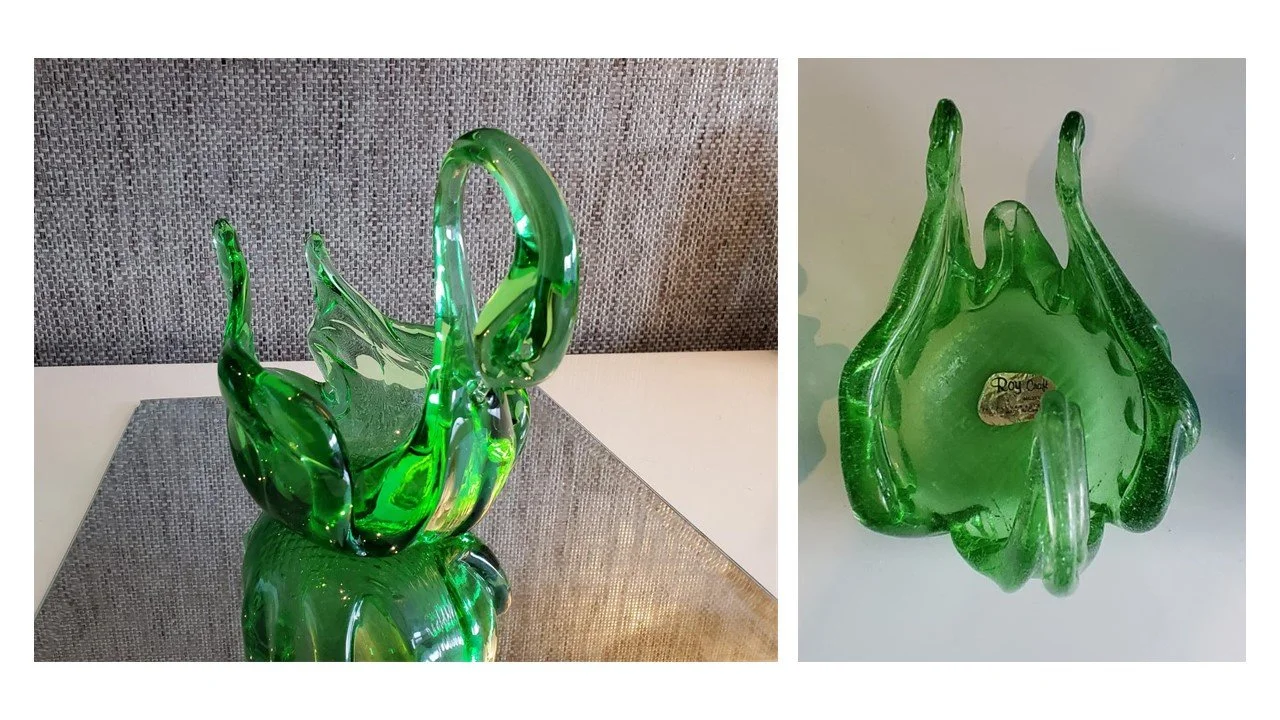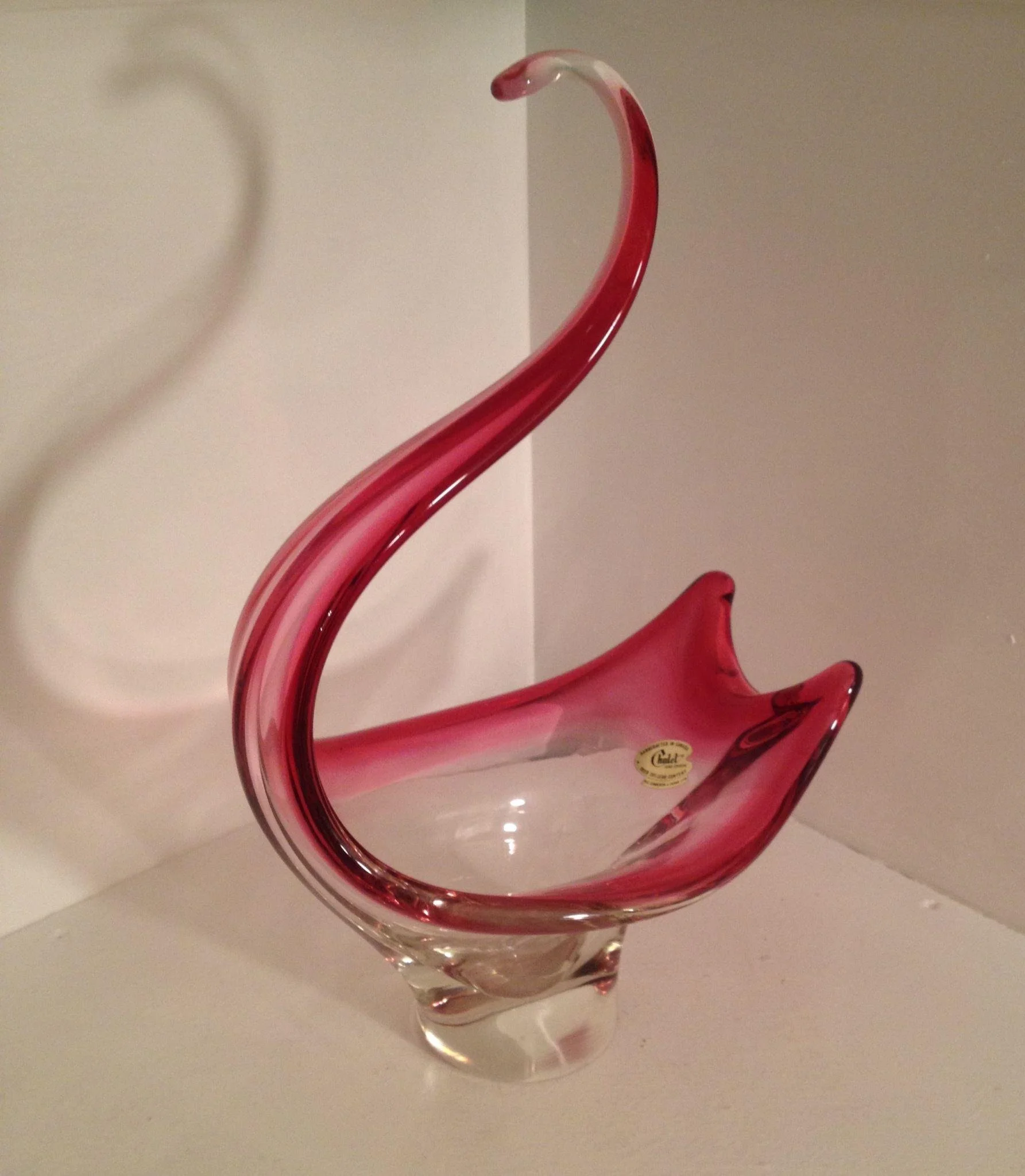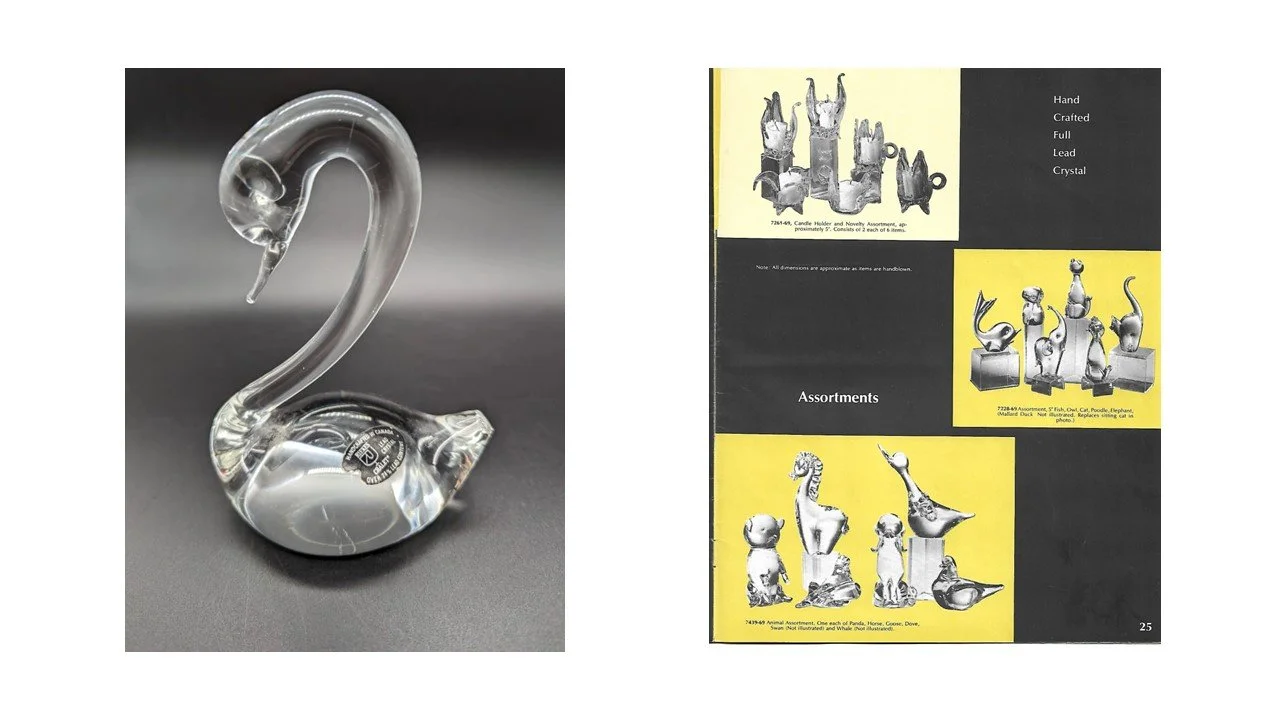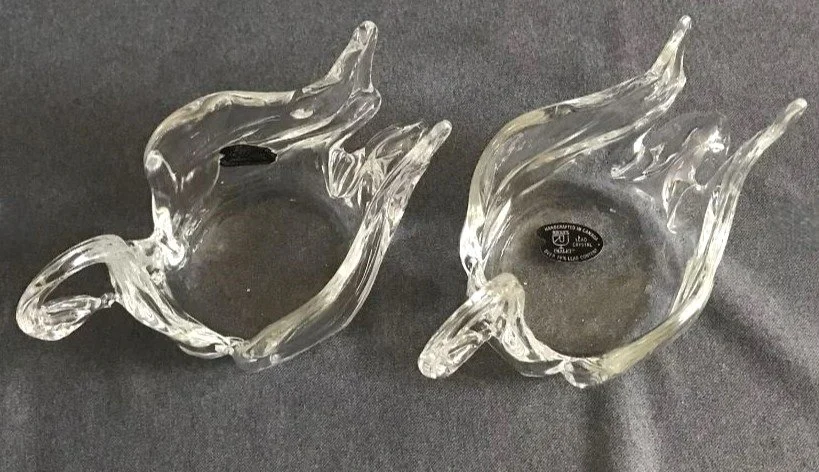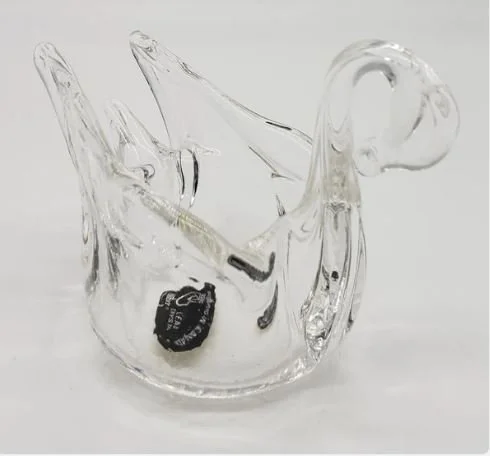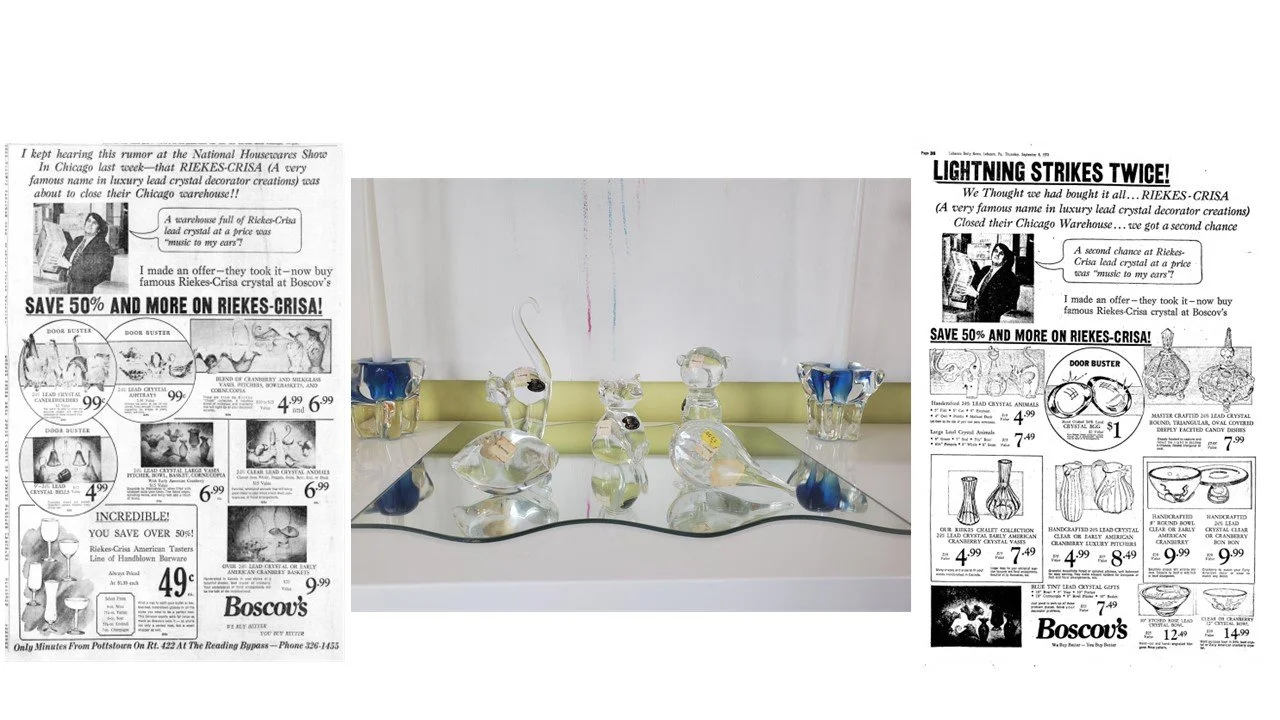The Chalet Swans
There is no other animal translated into art glass by Chalet as often and in as many varied forms as the swan. Hand-blown, the swan was produced as animal figurine, centerpiece (both regular production and mini sizes) and in an open-bowl dish style. Hand-molded, it was produced in assorted styles, sizes, colours, and finishes in bomboniere form. These are well catalogued on the Chalet inventory/production pages we currently reference. Not all style variations are shown but very good coverage, nevertheless.
Hand-blown:
The swan animal figurine # 619 on a Chalet catalogue page. See third figurine from left in 2nd row:
There is frequent confusion when it comes to determining whether a particular fowl is a Chalet Canada goose or a Chalet swan. For the purposes of this article, I have chosen to adhere to, for the majority part, what is shown on this page with regard to categorizing some figurines as a Canada goose versus a Chalet swan. So, if you do not see a figure here that you have in your collection as a swan, it may be for this reason. However, as others were included, I concede that it is definitely an arbitrary decision!
To the left of swan # 619 are shown 2 styles of Chalet Canada goose - # 563 and # 564. For some reason, # 564 pops up again in the 4th row and appears to be no different than the # 564 shown in the 2nd row. I have no explanation for this and as there are no sizes given cannot assume just a different height being shown. This is further exacerbated by the inferior quality of the photo reproduction we have to work with regarding this sheet. I do have possess a few original Chalet catalogue pages, gifted by Chalet Maestro Giulio Gatto, but this is not one of those.
A closer look at some of the figurines shown on this page that can be confusing to some collectors. The Chalet swan and the Canada geese styles here:
2 Canada goose figurines are shown here on the left and at middle. - # 563 and # 564. Beside and to the right of goose #564 is the Chalet swan figurine # 619.
These three in the typical 2-tone colour combination in which they are found.
These figurines were also done in clear crystal.
Canada goose # 564 at left and # 563 at right in this pairing from 50 Shades member and collector Kerri Forest. The neck of goose at right is in a more bent and forward position than shown in catalogue. Just a variation.
A clear crystal swan:
The Chalet swan might also be mistaken for the Chalet buffle head duck. The duck was also done in 2-tones and in clear crystal and is figurine # 620. Seen in the bottom row, middle, on the catalogue page.
The Chalet swan # 619:
It is most typically found in the 2-tone colour combination of bright blue/bright green:
This mated pair from the collection of member Troy Danby.
As I mentioned earlier, there are styles of Chalet swan figurines that are not featured on the Chalet catalogue page above:
The Chalet “split tail” swan. It has been found in more than one 2-tone colour combination:
This trio is also from the flock of Troy Danby.
Some variations of the style:
Note the slight differences between the figurines with regard to overall and base height, neck pose and position, colour placement, intensity, and tones.
The “paddle tail” swan figurine:
The figurines at top and middle form the collection of Troy Danby. The amber and green owned by Roy Prins.
This is an unusual swan style – the “twisted neck” style. It is a very rarely seen figurine. It was produced in both clear crystal and at least one 2-tone.
This picture gallery, Sabrina Brunetti photographer, gives a clear view of this pose:
In clear crystal:
Courtesy of Bradley Atkinson.
The last swan style/pose:
As detailed in a previous article, “The Large Coloured Chalet Animal Figurines,” Chalet produced larger scale swans. A quick review:
A very lovely Chalet interpretation of the swan:
This piece weighs over 2 pounds. Etched “Chalet Canada.” Photographs – Deborah Patterson.
These 2-tones are particularly interesting as the second colouring is limited and deliberately contained to a “water mark” where the bird would have floated in the water:
Deborah Patterson contributor.
From the collection of Troy Danby.
Mr. Danby has a crowded pond!
Swans are shown in an November 25, 1964 Morgan’s Department Store (later Hudson’s Bay) advertisement in the Toronto Star:
The Toronto Star is owned by Toronto Star Newspapers Limited, a subsidiary of Torstar Corporation and part of Torstar's Daily News Brands division.
A fourth:
A much more ornate figurine than typical.This one can be found swimming in Cindy Bishop-Laughlin’s pond.
It is kept company by this figurine of a fifth style:
Most unusual colour placement.
Cindy Bishop-Laughlin has another unusual larger figurine to show us:
And lastly:
Courtesy of Troy Danby.
Chalet’s iconic swan centerpieces were produced in 2-tones, clear crystal, cranberry in crystal, colour rimmed and “ribboned.” Production sizes shown start at 10 inches and their height range is up to 18 inches.
The blue/green 2-tone:
Etched “Chalet Canada.”
Although the catalogue page with this piece shows only a 10” height, the 2-tone here is 14”. The clear crystal stands at 12 inches.
Chalet artist and bomboniere Master Roberto De Marchi was asked about this very curious piece. Was it a broken and then repurposed swan?
His reply was “No.” He said major repairs on larger pieces like these were always too visible to not negatively impact the appearance and value of the piece so they were not done – a waste of time and money. They were discarded. This piece was made like this.
The swan centerpiece was done in another striking 2-tone combination. It is less frequently seen the the blue/green.
This closer look at a clear swan centerpiece courtesy of Cindy Bishop-Laughlin.
The cranberry in crystal swan centerpiece and the catalogue page on which it is featured:
Second row, from left to right:
“Swan” centerpiece. It is shown as being produced in 3 heights and with separate inventory numbers for each.
Inventory #12098 – 18” high
Inventory #12099 – 13” high
Inventory #12100 – 11” high
Original Chalet catalogue page gifted by Maestro Giulio Gatto.
From the collection of Darlene Spence.
A very marked colour variation. Colour could be affected by environmental factors in the factory as well as the condition and cleanliness of the crucible. As the crucibles aged, they degraded which did impact the mix.
Swan at left belongs to collector Cathy Young. The swan centerpiece on the right is from the collection of Wallace Addison White.
Although the next centerpieces are “coloured rimmed” as are the cranberry in crystal, there is no extended line of multiple forms with this colour placement.
Stunning from any angle.
In honey gold:
In blue:
And an unusual mix. It’s rather a hybrid of a colour rimmed with a 2-tone:
When I found this large and gorgeous piece, I UV light tested it as I was unsure whether it could have been coloured with uranium. “No. “ Nor is the more intensely coloured 2-tone swan shown above.
The Chalet “ribbon” swan centerpiece:
Photographs contributed by Cindy Bishop-Laughlin (top left), Troy Danby (top right), Deborah Patterson (bottom left) and Bradley Atkinson (bottom right).
A closer look. Troy Danby collector.
A swan centerpiece that is uranium!
To date, this is the only uranium swan centerpiece of which we are aware. Lucky owner is Cindy Bishop-Laughlin.
He does not want for company!
You may have noticed that there is an absence of solidly coloured swan centerpieces so far. Well, in my experience, so far in doing these articles, I always learn at least one thing for each and every topic. For this one – I could find absolutely no production height swan solids. Every single one I had on file, the new I discovered and the collectors I contacted and asked to measure theirs bore this out. All the solids were in heights from just under 9” to just under 10”. Each and every one.
Therefore, let’s look at the swan “mini” centerpieces. At this writing, they have only been found in solid tones of one colour. Blues, red, green, amber and a “Chalet champagne.” To date, no orange, purple or pink cranberry. There have been no uranium or clear crystal discovered as well. While height variation from one to the next is limited, there can be a marked difference in weight. This fact was pointed out to me by Cindy Bishop-Laughlin. Since she has quite a few for comparison, I think it’s a given.
The “minis” she measured and compared for me:
Her amber is the smallest at just barely 9”, the red is much thicker and heavier than the rest and her tallest just reaches 10.”
Dwain Robertson also did some measuring for this article.
Dwain’s swans both stand 9 1/2 “ tall. The cranberry in crystal shown above with this pair is 12 ½ inches in height.
This “Chalet champagne” colour is typically found in either Chalet minis or bomboniere.
Champagnes from the collection of Jo Highland.
One of these things is not like the others…
The Chalet swan dish was done in 2 styles. However, few of these were made and they were dropped from production as they did not prove popular.
This is production #A 77 and is the top form on the left- hand side of catalogue page. Donated to the collection of the Cornwall Community Museum. Original Chalet catalogue page courtesy of Chalet Maestro Giulio Gatto – one of my most valued Chalet “pieces.”
The second style was # A 76 and is at top on opposite (right hand) side of the page. I cannot show you a picture of a piece that we have discovered so have taken from the page.
Do not confuse Chalet swan dishes with a “kissing cousin” from Rossi’s “Heritage Glass Collection” line. This silver label is a Rossi branding – Chalet never used stickers or hang tags that did not have a company name.
Rossi dish at left.
For more details regarding Maestro Angelo Rossi and his connection to Chalet Artistic Glass please see these two articles: “The Faces of Chalet” and “The Chalet/Rossi Connections and Confusions.” The history and branding of Rossi’s Cornwall glasshouses is extremely well catalogued in “Chalet Crystal Clear Continued.”
Hand-molded swans – the small decorative (used as gifts at special celebrations) Chalet swan bomboniere. The only colours at present that we have not found these to be in are red and orange. There are several styles and different finishes. I spoke to Chalet artist and bomboniere Master Roberto De Marchi about these pieces:
Molten glass was poured into a mold, it was allowed to cool and then removed and worked and finished by hand. He was expected to produce 80-100 per shift.
A Chalet swan bomboniere created by Roberto:
From the personal collection of Chalet artist Roberto De Marchi. More details regarding the irradato finish will follow.
Base mold markings:
Again, catalogue page and examples of the style listed there to start:
You will see that the swan bomboniere on this page are in 2 sizes of the same style. They are # 1041 (6 inches) and #1021 (4 inches).
A third size of the same style is found on this second bomboniere page. This original page also courtesy of Maestro Gatto.
Half way down on left side of page, you can see #1040 which is 5 inches is now included along with the other larger (#1041) and the smaller (# 1021).
Styles # 1021, # 1040 and #1041 all have the wings and tail more down, back, and straight rather than upright.
However, there variation occurs as the wings and/or tails are typically different (being higher) one from the next.
However, there is variation in this as the wings and/or tails are typically different (being higher) one from the next.
There is also colour variation. Not only in shades but how it was used and/or placed:
A good illustration of production size range:
Large swan. # 1041, is 6” tall and the smaller is 4 ½” in height. Photo credit Eric Lachapelle.
A closer look, courtesy once more of Gionny Gueli, of another # 1041 – one of his 6” swan bomboniere:
Although the “1 head tucked to chest with wings straight back” shown above is the pose shown on Chalet bomboniere production/inventory sheets, there are 2 variations of this catalogue page “head to chest” style:
Variation 1:
Wings are up in this style of swan “head to chest” bomboniere.
Catalogue page pose at left. The “wings up” style right. Courtesy Gionny Gueli.
This grouping is not only a good illustration of this style variation but also that this second style came in more than one height and diameter.
A 6-inch version of both styles ( # 1041 at right) with a significantly smaller “wings up” in the foreground.
6” “wings up” in background. At left a 4 inch of same style and a 5” (# 1040) at right.
If you find it hard to distinguish between the two style, think of a swan boat ride. The “wings up” is one you could sit in!
A gorgeous grouping of the “wings up”
I received a great deal of assistance with this article from Gionny Gueli regarding the swan bomboniere – he pointed out details that I had missed as well as taking some wonderful photographs of his “swan boms” to share here.
An example of typical colour tone variation as well as showing production size range:
The third pose in this “head to chest” is the “2 heads to chest” Chalet swan bomboniere:
At left, 2-heads to chest bomboniere. On right, #1041.
In this photo, the “2 heads” is on right. Both these sets of bomboniere from the collection of Bradley Atkinson.
Photograph courtesy of Alex Wicks.
The “2-headed” swan form is less common than the “1 headed” swan bomboniere.
This very intense blue is often seen in the Chalet swan and bird bomboniere. From the collection of Nuria Sanchez.
All “heads to chest” together now!
Just a few of Gionny Gueli’s flock!
The second style shown on the catalogue sheet is found on the right-hand side of the page and one form up from the bottom. It is listed as being produced in 3 sizes – 5” (# 1022), 6” (#1042) and 7” (# 1043). It has a flat head that is tight to the body, no elongated and curved neck, and looks straight ahead. It is much rarer than the”1 head to chest” styles and variations.
Second catalogue style at top right.
From the collection of Kevin Kodak.
This # 1022 mated pair from Gionny Gueli shows a typical variation from the production size of 5 inches that is listed. The olive measure 3 ½ “ in height and the gold is 3”.
There is also a “Wings up” variation in this style:
For comparison:
All “flat heads” together now!
Thanks again to Gionny Gueli.
You have doubtless noticed in many of these examples the glass surface has a glazed appearance – a shimmer. This is due to its irradato finish.
What does this mean? How was this achieved? An irridato piece means that the glass skin has an iridescence. This finish is achieved by treating a piece while still hot with metal chlorides or by drenching a piece at the final stages with kerosene and then burning off the oil. Chalet used the first method. The drenching of and then burning off of gasoline is a very “old school” practice that , for obvious reasons, is not widely used present day.
For comparison:
Untreated glass at left and bomboniere with an irradato finish at right. Photo credit – Janne Wolsek
Another look - or several, provided by Carol Lincz.
The 3 swans at left (green, blue, and amber) do not have an irradato finish while the 3 on the right (pink, mint, and periwinkle) do.
The irradato finish was not limited to one style, size, or colour of swan bomboniere. Just a very few examples:
Top view down.
From the collection of Kim Tersteeg.
A huge swan bomboniere. It is close to 8 inches in height. Photo courtesy of Daniel Lynch.
And a very lovely opalescent irradato from the collection of Darlene Merrett Puckey.
The swan bomboniere were also done in clear crystal. They have only been found, to date, in the ‘”1 head to chest” and “Wings Up” styles. These can also be found with an irradato finish.
Irradato swan at right. Courtesy of Bradley Atkinson.
And in the flat head out style.
“Head Out and Wings Up” swans from the collection of Gionny Gueli.
Hand-molded clear crystal swan candleholder bomboniere are also common. The base of a candleholder bomboniere is always flat. Very often you will find that the mold marks have been ground off to ensure that it will rest completely level – for obvious reasons. One such example:
As well as retaining the remnants of its original Riekes Crisa distributor’s label, it also retained a retailer’s sticker.
This “1 head to the chest” style of swan candleholder from the collection of the Cornwall Community Museum has a flat base but retains its mold marking.
As detailed in the articles and reference book mentioned earlier, there is understandable confusion when it comes to identifying certain Chalet-made pieces from some made in the Angelo Rossi glass houses. This is very apt when referencing unmarked bomboniere as among the Chalet equipment that Rossi and Jaslow bought at the company’s bankruptcy sale were their molds the hand-molded forms – the ones for the bomboniere included:
To illustrate, a page from a 1981 Rossi catalogue courtesy of the Cornwall Community Museum:
If you had not been told this was from a Rossi glasshouse …
The Rossi “Heritage Glass Collection” stickered piece at left is from the collection of Kevin Kodak. The Chalet swan bomboniere at right.
Rossi used an irradato finish on the majority of his coloured bomboniere. A “id tell” – if an unmarked bomboniere is amber or grass green, it is not a Rossi made piece – it is Chalet. Rossi did not produce bomboniere pieces in those colours. Rossi pieces are generally pinks and blues – with the odd colour, such as the orange shown center below, thrown into the mix.
These are also not Chalet made although they are commonly mis-identified as such on-line:
Photographs courtesy of Katie Duke.
Murano made:
Some others:
There has been a variety of markings seen on both the hand-blown and hand-molded Chalet swan figurines, centerpieces, dishes and bomboniere that we have found. Both company etchings, hang tags, and labels as well as distributor stickers.
Company markings:
The iconic etched “Chalet Canada” signature. Courtesy of Bradley Atkinson.
The “big black” Chalet label. From the collection of Troy Danby.
The small gold foil “Lead Crystal” Chalet sticker. Photograph courtesy of Jeremiah Shaver.
This sticker also is found on the animal figurines and larger swan centerpieces.
An exceedingly rare Chalet indicia:
The 4-sided “Boutique Collection” hang tag. For detailed information concerning all of Chalet’s company branding , marketing, and retailing, please see “Chalet Crystal Clear Continued.” Shown here on a larger swan figurine from the collection of Troy Danby.
Distributors’ branding:
The Montral area distributor Chantili:
Swan animal figurine at left from the collection of group member Pina Pina.
We have found advertising for the Chantili marked Chalet swan bomboniere from a chain retailer for this distributor:
Featured in the May 8, 1969 editions of the Montreal Daily Star and the Toronto Daily Star. The Toronto Daily Star is a subsidiary of the Torstar Corporation. The Montreal Daily Star is no longer in publication.
Tex Novelty was also a Montreal and area distributer – Chalet’s first. Product carried by this supplier was branded ‘Roy Craft.”
You will note here that this piece is filled with a multitude of tiny bubbles. This is not bullicante. Rather, it is what Master De Marchi referred to as ‘not good glass.” Occasionally the glass mix was contaminated – even gritty and working with it was extremely difficult and the end product deemed inferior. This is an example of such.
An example of different distributors carrying the same product. Despite advertising claims from retailers or distributors, Chalet did not grant exclusivity to lines, forms, or colours. I am not sure why some collectors espouse this as it is not borne out by fact. Proof positive – just one example:
Same product, same style, same colour – different distributors.
Chalet’s largest distributor, N. C. Cameron & Sons Ltd., also carried both hand-blown and the hand-molded Chalet swans:
And of course, Chalet’s largest American distributor Riekes Crisa carried Chalet swans. These were limited to animal figurines, bomboniere and candleholder bomboniere.
The swan figurine is only mentioned, not illustrated, in Assortment a# 7439-69 t bottom right of this Riekes page from the Riekes 1976 General Catalog. However, we do have a figurine with the oft seen black artist palette-shaped Riekes sticker.
The swan animal figurine is not shown as part of the “John Riekes Collection” but I did find one so labelled:
Both styles of the swan bomboniere are shown as part of this collection but they are typically found with the black Riekes label:
The later undated Riekes catalogue now shows the flat-bottom “Wings Up” bomboniere as candleholders:
Another with its base ground smooth.
American retailer advertising has also been found for this distributor:
1973 Boscov’s – family-owned chain still operating today.
I was lucky enough to find 2 lots of animals and many of them retained not only the Riekes label but Boscov’s retail stickers.
1974 – Richman Gordman – single store Omaha, Nebraska department store. This is the last known advertising for Chalet product distributed through Riekes Crisa.
Now let’s see who’s swimming in the Chalet pond today.
